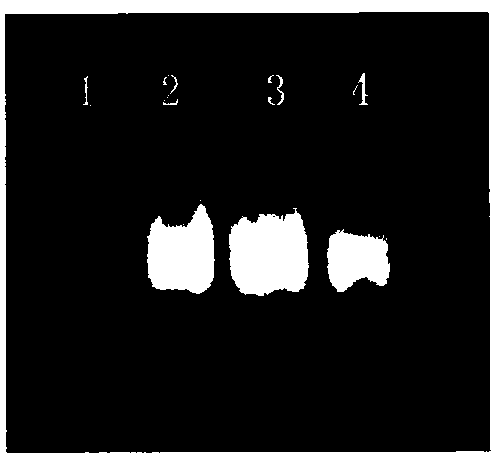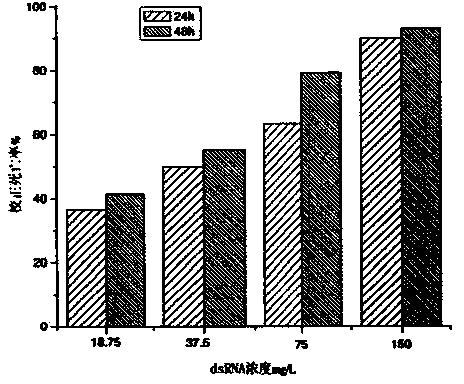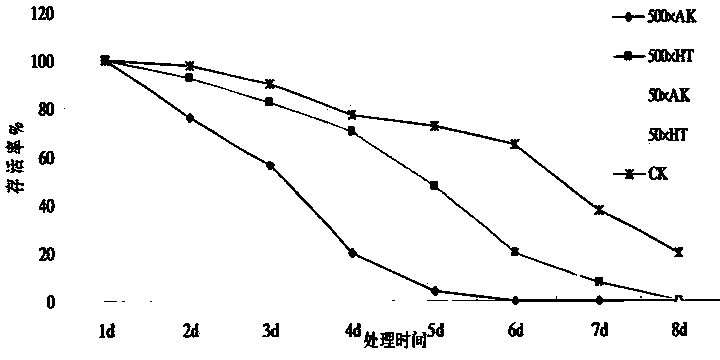Method for effectively controlling agricultural pest mites by RNAi
A cloning method, RT-PCR technology, applied in the field of agricultural biology, can solve the problems of difficult operation of RNAi molecular technology and less research on mites, and achieve the effects of reducing experimental costs, reducing mechanical damage, and simplifying experimental operations
- Summary
- Abstract
- Description
- Claims
- Application Information
AI Technical Summary
Problems solved by technology
Method used
Image
Examples
Embodiment 1
[0056] (1) Get 100-150 spider mites, and use the TRIzol method to extract total RNA;
[0057] (2) Synthesizing the first strand of cDNA;
[0058] (3) The sequence of the gene fragment was obtained from the transcriptome of the spider mite, and after homology comparison at http: / / www.ncbi.nlm.nih.gov / , it was predicted to be the AK gene, and P1 and P1 were designed using Primer premier 5.0 software. P2, amplified by RT-PCR method;
[0059] Upstream primer (P1): 5'GCGACTTGTGAACCTG 3' (SEQ ID NO.2),
[0060] Downstream primer (P2): 5'TCTGCTGACGCTGAAA 3' (SEQ ID NO.3);
[0061] The PCR reaction program was: denaturation at 94°C for 5 min, 1 min at 94°C, 1 min at 56°C, 1 min at 72°C, 32 cycles, and extension at 72°C.
[0062] PCR reaction system (25μL):
[0063] 10×Ex PCR Buffer 2.5μL
[0064] 2.5mM dNTP Mixture 2.0μL
[0065] cDNA template 3 μL
[0066] 10 μM upstream primer P1 1.0 μL
[0067] 10 μM downstream primer P2 1.0 μL
[0068] 5U / μL Ex Taq 0.25μL
[0069] ...
Embodiment 2
[0077] (1) Extract the recombinant plasmid PMD18-T-AK cloned in the first aspect of the present invention, and perform double digestion with HindIII and SacII to obtain two cohesive ends.
[0078] (2) The digested product is separated by agarose gel electrophoresis, and the target DNA fragment is recovered Figure X.
[0079] (3) The L4440 plasmid was also double digested with HindIII and SacII to obtain the same sticky end as in (1).
[0080] (4) The digested product is separated by agarose gel electrophoresis, and the target DNA fragment is recovered as vector image X.
[0081] (5) Ligate the target fragment obtained in (2) and the L4440 plasmid vector fragment obtained in (4) with T4 DNA ligase, transform into Escherichia coli HT115, and spread on the double antibody LB plate containing (Amp+Tet), 37°C Cultivate overnight;
[0082] (6) Pick a single colony, inoculate it in 2ml LB medium (Amp+Tet), culture overnight at 37°C, extract the plasmid and carry out enzyme digestio...
Embodiment 3
[0088] (1) Cut the double-sided tape into 2cm length and paste it on one end of the glass slide
[0089] (2) Select a healthy female adult mite, gently pick it up with a small brush, and stick its back on the adhesive tape, and be careful not to stick the feet, pedicles and mouthparts.
[0090] Glue 30 heads per piece, arrange them in three rows, then put the slides in a clean, non-toxic and moist tray, and place them in an incubator at 28±1°C
[0091] (3) After 0.5 hours, pick out inactive and dead individuals under a binocular dissecting microscope and make up 30 for use;
[0092] (4) Use a 2.5 μL pipette gun to add an appropriate amount of dsRNA to the back of each worm under a stereo microscope
[0093] (5) Death standard: lightly touch the mite body with a small brush, and those who do not move their limbs are considered dead
[0094] (6) Feed continuously for 48 hours, count the mortality rate every 24 hours, the results are shown in Table 1 and figure 2 , from Table...
PUM
 Login to View More
Login to View More Abstract
Description
Claims
Application Information
 Login to View More
Login to View More - R&D
- Intellectual Property
- Life Sciences
- Materials
- Tech Scout
- Unparalleled Data Quality
- Higher Quality Content
- 60% Fewer Hallucinations
Browse by: Latest US Patents, China's latest patents, Technical Efficacy Thesaurus, Application Domain, Technology Topic, Popular Technical Reports.
© 2025 PatSnap. All rights reserved.Legal|Privacy policy|Modern Slavery Act Transparency Statement|Sitemap|About US| Contact US: help@patsnap.com



